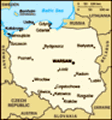Polish Geography, Poland Geography
Advertisement
Location: Central Europe, east of Germany
Geographic coordinates: 52 00 N, 20 00 E
Map references: Europe
Area: Total: 312,685 sq km land: 304,465 sq km water: 8,220 sq km
Area - comparative: Slightly smaller than New Mexico
Land boundaries: Total: 2,788 km border countries: Belarus 407 km, Czech Republic 658 km, Germany 456 km, Lithuania 91 km, Russia (Kaliningrad Oblast) 206 km, Slovakia 444 km, Ukraine 526 km
Coastline: 491 km
Maritime claims: Territorial sea: 12 nm exclusive economic zone: defined by international treaties
Climate: Temperate with cold, cloudy, moderately severe winters with frequent precipitation; mild summers with frequent showers and thundershowers
Terrain: Mostly flat plain; mountains along southern border
Elevation extremes: Lowest point: near Raczki Elblaskie -2 m highest point: Rysy 2,499 m
Natural resources: Coal, sulfur, copper, natural gas, silver, lead, salt, amber, arable land
Land use: Arable land: 45.91% permanent crops: 1.12% other: 52.97% (2001)
Irrigated land: 1,000 sq km (1998 est.)
Natural hazards: Flooding
Environment - current issues: Situation has improved since 1989 due to decline in heavy industry and increased environmental concern by post-Communist governments; air pollution nonetheless remains serious because of sulfur dioxide emissions from coal-fired power plants, and the resulting acid rain has caused forest damage; water pollution from industrial and municipal sources is also a problem, as is disposal of hazardous wastes; pollution levels should continue to decrease as industrial establishments bring their facilities up to European Union code, but at substantial cost to business and the government
Environment - international agreements: Party to: Air Pollution, Antarctic-Environmental Protocol, Antarctic-Marine Living Resources, Antarctic Seals, Antarctic Treaty, Biodiversity, Climate Change, Climate Change-Kyoto Protocol, Desertification, Endangered Species, Environmental Modification, Hazardous Wastes, Kyoto Protocol, Law of the Sea, Marine Dumping, Ozone Layer Protection, Ship Pollution, Wetlands signed, but not ratified: Air Pollution-Nitrogen Oxides, Air Pollution-Persistent Organic Pollutants, Air Pollution-Sulfur 94
Geography - note: Historically, an area of conflict because of flat terrain and the lack of natural barriers on the North European Plain
Advertisement
The information here has been derived from Public Domain Sources such as the CIA World Factbook. No liability can be taken for any inaccuracies.
Tot: 0.079s; Tpl: 0.008s; cc: 4; qc: 6; dbt: 0.0084s; 1; m:domysql w:travelblog (10.17.0.13); sld: 1;
; mem: 1.1mb

 Poland is an ancient nation that was conceived near the middle of the 10th century. Its golden age occurred in the 16th century. During the following century, the strengthening of the gentry and internal disorders weakened the nation. In a series of ...
Poland is an ancient nation that was conceived near the middle of the 10th century. Its golden age occurred in the 16th century. During the following century, the strengthening of the gentry and internal disorders weakened the nation. In a series of ...
